Catholic Customs
 |
 |
 |
 |
 |
 |
 |
The Sweetness of Christmas Charity
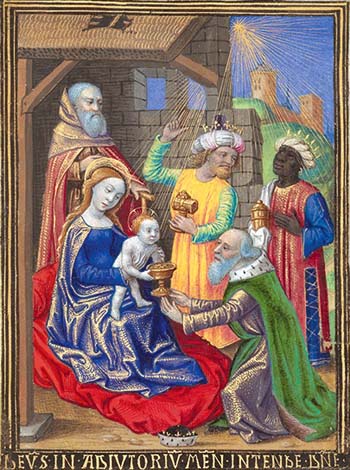
Throughout the Twelve Days of Christmas, Catholic households maintained the spirit of charity by generously giving alms to the poor and opening their homes to friends and passersby to enjoy delicious food from the Christmas tables that were laden with the meats, breads and the sweets of Christmas. Even a great lord would welcome any traveler, be he a beggar or a king, to partake of the Christmas feast in his chateau hall, and many lesser nobles opened their homes to the peasants who lived on their lands.
The special Christmas desserts vary in every region and family. The richness and sweetness of the desserts that are heavily laden with nuts, dried or candied fruits, and spices is symbolic of the joy that the Church gives to her children. Coming from the East, the spices especially reminded our forefathers of the gifts of the Three Wise Men of old.
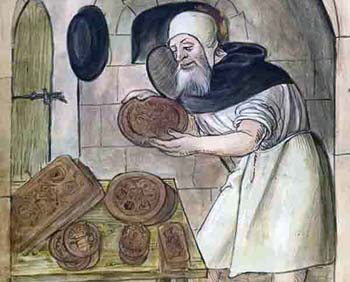 Many of the sweets themselves were fashioned into forms representing the Nativity scene. In Medieval Halls, after every course of the Christmas feast beautifully carved sugar sculptures depicting scenes from the Nativity were brought to the table. Even to this day this tradition is maintained as attested by the numerous cakes and pastries of different lands that are adorned with images from the Nativity intricately pressed, cut or painted onto the sweets.
Many of the sweets themselves were fashioned into forms representing the Nativity scene. In Medieval Halls, after every course of the Christmas feast beautifully carved sugar sculptures depicting scenes from the Nativity were brought to the table. Even to this day this tradition is maintained as attested by the numerous cakes and pastries of different lands that are adorned with images from the Nativity intricately pressed, cut or painted onto the sweets.
Gingerbread and other spiced cookies are enjoyed in nearly every country during Christmas. Gingerbread is thought to be one of the oldest treats made for Christmas, inspired by the Crusaders who brought home spices from the Holy Land. In the Middle Ages, a paste of bread crumbs, honey and spices was molded and decorated into marvelous designs; with the passing of time it took on more of a cake or cookie form.
Germanic peoples continue to enjoy many different types of gingerbread, each shaped into figures or pressed into intricate cookie molds. In the Mediterranean lands of Greece, light shortbread cookies of ancient origin are baked with a clove in their centers in memory of the gift of Frankincense. (1)
Fruitcakes also hold a prominent place on the Christmas table, for the Christ Child was the most perfect fruit that this earth has ever produced. The Germans bake sweet fruit-filled breads with tapered ends and a ridge down the center to give the likeness of a swaddled babe known as Christstollen.
Wreath shaped cakes are baked in many lands as symbols of everlasting life: e.g. the Dutch marzipan filled Kerstkrans (“Christmas Wreath”) and the Swedish Julbrod filled with candied fruit. French families enjoy the Gâteaux aux fruits de Noel fruitcake, Chileans have their spiced fruit filled Pan de Pascua, the Rumanians make a turta with many layers of thinly rolled dough symbolic of the swaddling clothes, and Italians of Milan serve the traditional fruit-filled panettone.
 British homes serve plum pudding and mincemeat pie, originally shaped in the rectangular shape of a manger with a hump in the middle to suggest the swaddled child. Sometimes a small figure of the Christ Child was even placed on top of the mince pie, which horrified the Puritans causing them to ban the pie altogether. (2)
British homes serve plum pudding and mincemeat pie, originally shaped in the rectangular shape of a manger with a hump in the middle to suggest the swaddled child. Sometimes a small figure of the Christ Child was even placed on top of the mince pie, which horrified the Puritans causing them to ban the pie altogether. (2)
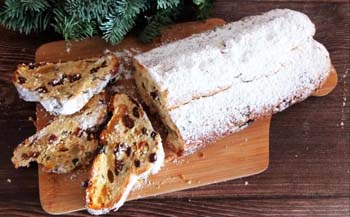 The Italian housewives and bakers also made an effort to form their Christmas pastries into figures that resembled the objects of the Christ Child: His sheets, pillow, cradle and Our Lady’s milk. In Apulia, Italy, after all of the dough was shaped and fried, an Ave Maria was said over the last piece of fried dough that was tossed into the fire to bring blessings to the house. (3)
The Italian housewives and bakers also made an effort to form their Christmas pastries into figures that resembled the objects of the Christ Child: His sheets, pillow, cradle and Our Lady’s milk. In Apulia, Italy, after all of the dough was shaped and fried, an Ave Maria was said over the last piece of fried dough that was tossed into the fire to bring blessings to the house. (3)
The sweets of Christmas were some of the most cherished gifts bestowed on friend and family. The Spaniards expressed their friendship by exchanging gifts of turrón (nougat), a tradition that found its way to Latin America. Many Norwegian housewives baked fourteen different kinds of small cakes, so that on each of the fourteen days of Christmas entertaining, the guest would have a new cake. (4)
An old Italian cake that used to be exchanged in place of calling cards as a sign of friendship was the Magi Cake. One such Magi Cake presented to the Prince of Borghese was adorned with his coat of arms and stretched six meters long. (5)
Christmas gift-giving: The Christ Child’s legacy
Christmas is indeed a natural time for gift giving, for it is when the greatest of gifts was bestowed upon mankind: the Son of God. Medieval peasants gave gifts of cakes, produce or fowl to their lords at Christmas. This custom continued into the early 1900s among tenants in England and Spain.
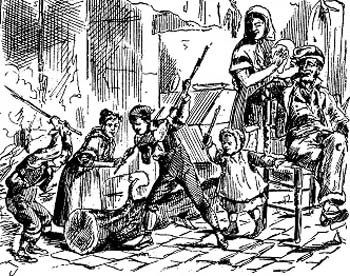 Gifts were often exchanged at some point during the Christmas Eve meal in Germany, Austria, Poland and Italy. The children’s gifts came in a marvelous way to those who had been good. Discipline rods, coal or nothing at all was left for disobedient children.
Gifts were often exchanged at some point during the Christmas Eve meal in Germany, Austria, Poland and Italy. The children’s gifts came in a marvelous way to those who had been good. Discipline rods, coal or nothing at all was left for disobedient children.
Children from Cataluña, Spain, awaited the arrival of a large hollow log called “uncle,” which was brought into the house a few days before Christmas. On Christmas Day, the children took turns beating “uncle,” which was often suspended from the ceiling and singing songs asking “him” to be generous; if they had been good, the log was filled with sweets, toys and coins that tumbled out as each child beat the log. (6)
The Christ Child Himself would visit the earth to bring gifts for good children in many lands. How fervently prayers were said on Christmas Eve Night to not be forgotten by the Infant King. Many Slavic children gladly made the sacrifice of sleeping on a bedding of straw and hay during this Holy Night so that by sharing in Our Lord’s poverty they might receive His graces. (7)
At dark on Christmas Eve, German children found the Christmas tree adorned and gifts left by the Christ Child. In Poland and Hungary, the Christ Child or an Angel was said to visit homes and hang sweets on the podłaźnik, Christmas tree, or laid out on a white sheet discovered by the children after the Christmas Eve meal. (8) Good Belgian children found an engelskoek (angel's cake) under their pillow on Christmas morning which was brought by the Christ Child or the Archangel Gabriel. (9)
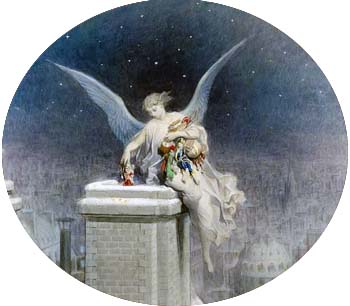 In some areas of Spain and Latin America, the children went to sleep on Christmas Night, catching one last glimpse of the empty Manger in their Crèche. During the novena leading up to Christmas, the children had left letters to the Christ Child before the empty Manger to be taken up to Heaven by the Angels. They awakened in the morning knowing with their requests answered, for they found the Christ Child in His Crib surrounded with gifts that He had brought for them from Heaven. (10)
In some areas of Spain and Latin America, the children went to sleep on Christmas Night, catching one last glimpse of the empty Manger in their Crèche. During the novena leading up to Christmas, the children had left letters to the Christ Child before the empty Manger to be taken up to Heaven by the Angels. They awakened in the morning knowing with their requests answered, for they found the Christ Child in His Crib surrounded with gifts that He had brought for them from Heaven. (10)
Bohemian children also went to the Nativity Scene to find their gifts left by the Christ Child as He stopped by their house on His chariot drawn through the air by four white horses. (11)
In many areas of France, children set their shoes set out by the hearth before the Yule log so that "Little Jesus" would come with His Angels to fill their shoes with gifts on Christmas Eve. They found their shoes laden with presents when they arrived home from Midnight Mass. Breton children believed that the Christ Child entered the house through the chimney, because it was purified by fire, unlike the doorway used by people stained with sin. (12)
In Burgundy, children were told to leave the room after the Yule log was brought inside, so that “Little Jesus” could come and hide sweets in the log. When the children were called back, they searched the log to find “Little Jesus’” gifts. (13) Some Italian families had a similar custom except that they blindfolded the children and had them recite poems for the Christ Child. After each child had made his recitation, the blindfolds were removed and the children were rewarded by their King with gifts that sat on the Yule log. (14)
Other Christmas gift-bringers
In some countries, other characters assisted the Christ Child as gift bringers. Children from the Neopolitan village of Ciminna awaited the arrival of a raggedly dressed woman named the Old Woman of Christmas (La Vecchia di Natale) who walked the streets on Christmas Eve leaving fruits and sweets. (15)
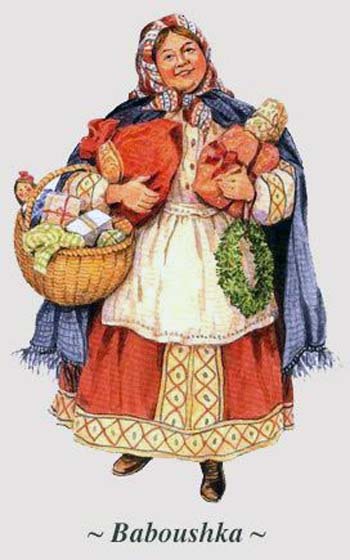 Another old woman called Babushka brought gifts for Russian children, who were told how she had been roaming the earth since the Birth of Our Lord. Several legends explain how she was doomed to this fate. In one legend, the Magi were said to have stopped at her home to bid her join them on their journey to see the King of Kings. She spurned their offer at first, but later repented and attempted to retrace their footsteps, but without success. Another legend recounts that the Holy Family sought her hospitality during the Flight to Egypt, but she refused.
Another old woman called Babushka brought gifts for Russian children, who were told how she had been roaming the earth since the Birth of Our Lord. Several legends explain how she was doomed to this fate. In one legend, the Magi were said to have stopped at her home to bid her join them on their journey to see the King of Kings. She spurned their offer at first, but later repented and attempted to retrace their footsteps, but without success. Another legend recounts that the Holy Family sought her hospitality during the Flight to Egypt, but she refused.
Regardless of how she sinned, all stories agree that she makes reparation by wandering the whole earth searching for the Child and leaving gifts on Christmas Eve for every good Russian child in hopes that one day her gifts would be laid at the feet of the Babe whom she sought. (16)
Thus did Our Lord’s Nativity inspire admirable displays of charity throughout all of Christendom!
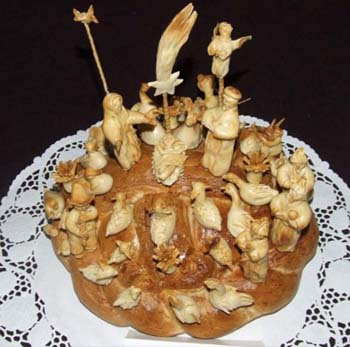

Posted December 20, 2024
The special Christmas desserts vary in every region and family. The richness and sweetness of the desserts that are heavily laden with nuts, dried or candied fruits, and spices is symbolic of the joy that the Church gives to her children. Coming from the East, the spices especially reminded our forefathers of the gifts of the Three Wise Men of old.

Medieval gingerbread baker; below, Nativity scene molded on a German gingerbread
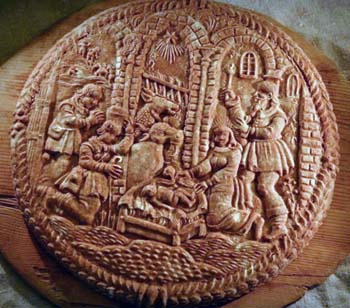
Gingerbread and other spiced cookies are enjoyed in nearly every country during Christmas. Gingerbread is thought to be one of the oldest treats made for Christmas, inspired by the Crusaders who brought home spices from the Holy Land. In the Middle Ages, a paste of bread crumbs, honey and spices was molded and decorated into marvelous designs; with the passing of time it took on more of a cake or cookie form.
Germanic peoples continue to enjoy many different types of gingerbread, each shaped into figures or pressed into intricate cookie molds. In the Mediterranean lands of Greece, light shortbread cookies of ancient origin are baked with a clove in their centers in memory of the gift of Frankincense. (1)
Fruitcakes also hold a prominent place on the Christmas table, for the Christ Child was the most perfect fruit that this earth has ever produced. The Germans bake sweet fruit-filled breads with tapered ends and a ridge down the center to give the likeness of a swaddled babe known as Christstollen.
Wreath shaped cakes are baked in many lands as symbols of everlasting life: e.g. the Dutch marzipan filled Kerstkrans (“Christmas Wreath”) and the Swedish Julbrod filled with candied fruit. French families enjoy the Gâteaux aux fruits de Noel fruitcake, Chileans have their spiced fruit filled Pan de Pascua, the Rumanians make a turta with many layers of thinly rolled dough symbolic of the swaddling clothes, and Italians of Milan serve the traditional fruit-filled panettone.

Christstollen, turta and Mincemeat Pie all symbolize Our Lord in His swaddling clothes

The famous Christmas stollen
The sweets of Christmas were some of the most cherished gifts bestowed on friend and family. The Spaniards expressed their friendship by exchanging gifts of turrón (nougat), a tradition that found its way to Latin America. Many Norwegian housewives baked fourteen different kinds of small cakes, so that on each of the fourteen days of Christmas entertaining, the guest would have a new cake. (4)
An old Italian cake that used to be exchanged in place of calling cards as a sign of friendship was the Magi Cake. One such Magi Cake presented to the Prince of Borghese was adorned with his coat of arms and stretched six meters long. (5)
Christmas gift-giving: The Christ Child’s legacy
Christmas is indeed a natural time for gift giving, for it is when the greatest of gifts was bestowed upon mankind: the Son of God. Medieval peasants gave gifts of cakes, produce or fowl to their lords at Christmas. This custom continued into the early 1900s among tenants in England and Spain.

Children from Cataluña, Spain beating ‘uncle’ to receive sweets
Children from Cataluña, Spain, awaited the arrival of a large hollow log called “uncle,” which was brought into the house a few days before Christmas. On Christmas Day, the children took turns beating “uncle,” which was often suspended from the ceiling and singing songs asking “him” to be generous; if they had been good, the log was filled with sweets, toys and coins that tumbled out as each child beat the log. (6)
The Christ Child Himself would visit the earth to bring gifts for good children in many lands. How fervently prayers were said on Christmas Eve Night to not be forgotten by the Infant King. Many Slavic children gladly made the sacrifice of sleeping on a bedding of straw and hay during this Holy Night so that by sharing in Our Lord’s poverty they might receive His graces. (7)
At dark on Christmas Eve, German children found the Christmas tree adorned and gifts left by the Christ Child. In Poland and Hungary, the Christ Child or an Angel was said to visit homes and hang sweets on the podłaźnik, Christmas tree, or laid out on a white sheet discovered by the children after the Christmas Eve meal. (8) Good Belgian children found an engelskoek (angel's cake) under their pillow on Christmas morning which was brought by the Christ Child or the Archangel Gabriel. (9)

The Christ Child with his angels lays gifts in a French child’s shoes
Bohemian children also went to the Nativity Scene to find their gifts left by the Christ Child as He stopped by their house on His chariot drawn through the air by four white horses. (11)
In many areas of France, children set their shoes set out by the hearth before the Yule log so that "Little Jesus" would come with His Angels to fill their shoes with gifts on Christmas Eve. They found their shoes laden with presents when they arrived home from Midnight Mass. Breton children believed that the Christ Child entered the house through the chimney, because it was purified by fire, unlike the doorway used by people stained with sin. (12)
In Burgundy, children were told to leave the room after the Yule log was brought inside, so that “Little Jesus” could come and hide sweets in the log. When the children were called back, they searched the log to find “Little Jesus’” gifts. (13) Some Italian families had a similar custom except that they blindfolded the children and had them recite poems for the Christ Child. After each child had made his recitation, the blindfolds were removed and the children were rewarded by their King with gifts that sat on the Yule log. (14)
Other Christmas gift-bringers
In some countries, other characters assisted the Christ Child as gift bringers. Children from the Neopolitan village of Ciminna awaited the arrival of a raggedly dressed woman named the Old Woman of Christmas (La Vecchia di Natale) who walked the streets on Christmas Eve leaving fruits and sweets. (15)

Regardless of how she sinned, all stories agree that she makes reparation by wandering the whole earth searching for the Child and leaving gifts on Christmas Eve for every good Russian child in hopes that one day her gifts would be laid at the feet of the Babe whom she sought. (16)
Thus did Our Lord’s Nativity inspire admirable displays of charity throughout all of Christendom!

A Serbian Christmas bread decorated with figures
from the creche
- Ann Ball, Catholic Traditions in Cooking (Huntington, Indiana: Our Sunday Visitor, 1993), p. 15.
- Francis X. Weiser, The Christmas Book (New York: Harcourt, Brace and Company, 1952), p. 149.
- Carol Field, Celebrating Italy (New York: William Morrow and Company, 1990), p. 255.
- Dorothy Gladys Spicer, Festivals of Western Europe (New York: The H. W. Wilson Company, 1958), p. 167.
- Ann Ball, Catholic Traditions in Cooking, p. 24.
- Nina Epton, Spanish Fiestas (Cranbury, New Jersey: A. S. Barnes and Company, 1969), p. 208.
- Ibid., p. 171.
- https://lamusdworski.wordpress.com/2015/12/06/wigilia/
- Spicer, Festivals of Western Europe, p. 30.
- Weiser, The Christmas Book , pp. 161, 169.
- William S. Walsh, Curiosities of Popular Customs and of Rites, Ceremonies, Observances, and Miscellaneous Antiquities (Philadelphia: J. B. Lippincott Company, 1898), p. 822.
- https://bonjourfrombrittany.wordpress.com/2021/12/18/some-lost-christmas-traditions-from-brittany/
- Christmas in France (Chicago, Illinois: World Book-Childcraft International, 1980), pp. 55, 65.
- Spicer, Festivals of Western Europe, p. 112.
- Field, Celebrating Italy, p. 254.
- Francis X. Weiser, The Christmas Book, p. 162.

Posted December 20, 2024
______________________
______________________
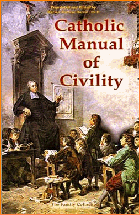 |
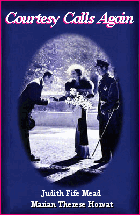 |
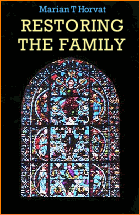 |
 |
 |
 |


